Share On Social!
Latinos make up over 60% of residents in Tulare County, many of them working for little pay on large farms in California’s fertile Central Valley. Some of these families aren’t getting proper nutrition, leading to diet-related conditions, like obesity and diabetes. When the local food bank revamped their nutrition policy to encourage more fresh produce donations, a local health advocate used her hard-earned knowledge and passion to support that policy, and implemented a creative way to get the valley’s extra fruits and veggies into the hands of those who need them.
EMERGENCE
Awareness: In Tulare County in California’s fertile Central Valley, fresh produce grows all over the place.
But for many area residents, this healthy produce doesn’t end up on their plates.
“Here we are in this agriculturally rich area and yet people who live here and work here are hungry, are impoverished,” said Sarah Ramirez, who grew up in Pixley, a small town in Tulare County.
After a lengthy educational career that culminated in earning a PhD from Stanford, Ramirez returned to Tulare County as a community-engaged scholar, combining her interdisciplinary training in public health, history, and cultural studies to give back to her community.
In Tulare County, 68% of adults are either overweight or obese, according to a 2010 Tulare County Nutrition and Food Insecurity Profile. And the obesity doesn’t stop with adults.
“Rates of childhood obesity were going through the roof,” said Sandy Beals, executive director of FoodLink for Tulare County, the area’s food bank.
Learn: Why was obesity such a problem?
Many community members do not own a vehicle or have easy access to public transportation, Ramirez said. The result: People are not getting the quality foods that often grow nearby.
“There isn’t a full-service grocery store that provides the best and most wholesome food at affordable prices here in the community,” Ramirez said.
According to Food Link, two out of every five children in Tulare County live in poverty.
When low-income folks seek help from the local food bank, Beals said the healthy options were slim. Unhealthy, highly processed donations made up the majority of what the food bank was taking in.
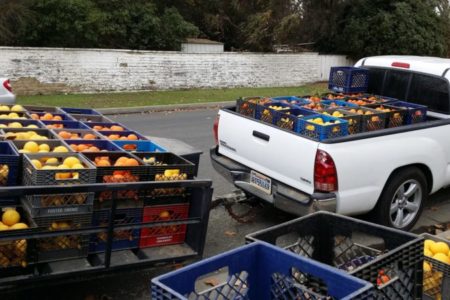
Source: https://www.facebook.com/behealthytulare
“We took a little internal look and realized we were part of the problem,” Beals said. “We were taking anything that was offered as a food donation and distributing it.”
Frame Issue: In 2000, Beals and her colleagues at the food bank decided that if they revamped their nutrition policies, they might be able to provide clients with healthier, more nutritious food.
DEVELOPMENT
Education: FoodLink changed its internal nutritional policy to promote health and wellness over cheap, easy eats. They follow a green, yellow, red system, Beals said.
- No more than 10% of food donations can be classified as “red”: all foods of poor nutritional quality, like cookies, chips, and high-sodium, highly processed crackers.
- At least half of food donations must be classified as “green”: all fruits and vegetables, lean meats, and dairy.
- Donations that fall somewhere between red and green are classified as “yellow”: pastas, breads, and soups, for example.
Additionally, FoodLink has a strict beverage donation policy that bans sugary sodas, said Beals.
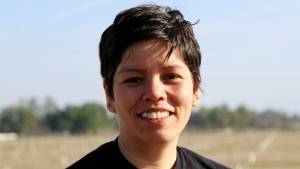
Source: http://www.cnn.com/2014/04/03/health/cnnheroes-ramirez/
“We have a zero policy on soda pop,” she said.
While FoodLink began implementing their new donation policy, Ramirez was working on the ground to motivate and educate Tulare County residents to live healthier, well-balanced lives.
She, along with her husband, who also grew-up in Pixley, started BeHealthy Tulare, a community group dedicated to creating an environment that makes equitable health possible for everyone by broadening access to local, sustainable, health-promoting resources, knowledge and skills. The group puts on frequent fitness activities, nutrition classes, and has a community garden.
“We wanted to start a group where the community sees the value of their own experiences,” said Ramirez, who is adamant about getting public input to ensure the community feels significant and heard.
One issue Ramirez educates the community on is food waste.
According to a USDA report, 41% of the available food supply in 2010 went uneaten. In Tulare County, these numbers are especially vivid, given the abundance of agriculture in the area.
“Looking outside and seeing trees just loaded with fruit, I was just feeling like, ‘Why aren’t we connecting these pieces?’” Ramirez said.
Because of this, Ramirez decided to get BeHealthy Tulare into produce gleaning.
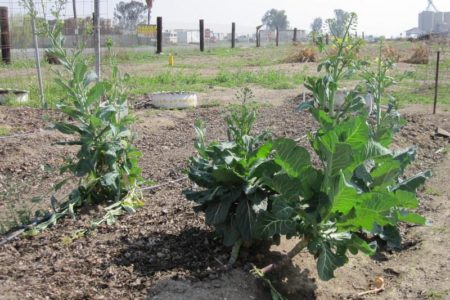
Source: https://www.facebook.com/behealthytulare
Produce gleaning involves volunteers who, with permission, gather leftover produce from farms or backyard gardens and donate them to charitable organizations, like food banks.
To learn more about what produce gleaning might look like in Tulare County, Ramirez researched what other gleaning groups were doing. Village Harvest in San Jose is one of the oldest groups collecting and donating unwanted produce, so Ramirez met with Craig Diserens, one of the founders, to learn more.
Ramirez said his knowledge and experiences were extremely helpful in conceptualizing how gleaning could work in Tulare County.
Mobilization: Back at FoodLink, Beals and her colleagues busily promoted their more rigorous nutritional policies.
“We let it be known in the community that healthy food is what we are going to be doing,” Beals said.
“Fresh produce is the No. 1 thing that we push.”
Beals said they get 90% of their fresh produce from local farmers, which is a great way to utilize local produce, but it’s not always cheap.
Gleaned produce, however, is free.
While doing her background research, Ramirez reached out to Beals—who she met several years ago while working for the local health department—to see if FoodLink would want the gleaned produce.
“Because of BeHealhty Tulare’s limited resources, it was important to plug into an already existing network,” Ramirez said.
FoodLink fit this need.
Ramirez set up conference calls between herself, Diserens from Village Harvest, and Beals, so Beals could ask questions about how gleaning would affect the food bank and what needed to be done on their end to be sure there were no legal issues.
Debate: In fact, there are a few legal issues a group has to address before they can begin produce gleaning or accepting gleaned produce, said Beals. Food banks cannot glean produce themselves to distribute through their channels. But non-profit groups like BeHealthy Tulare, can glean and donate the gleaned goods to the food bank.
“They take on the liability themselves,” Beals said.
ENACTMENT
Activation/Frame policy: To ensure the safety of volunteers and quality of the produce, BeHealthy Tulare crafted guidelines that all prospective volunteers must agree to and sign. By signing, they also hold BeHealthy Tulare harmless for any incident that might happen while out collecting food.
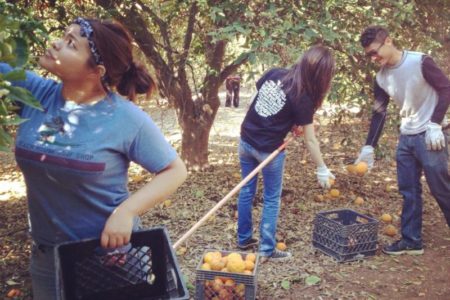
Source: https://www.facebook.com/behealthytulare
Homeowners or small-scale farmers with extra produce can register their fruit trees with BeHealthy Tulare if they would like volunteers to come pick extra fruit. On the organization’s website, homeowners can fill out a form that asks specific questions about the produce trees, like height and ease of access. They can even specify how much they would like to have leftover for their household. They are also given guidelines about the condition the fruits should be in, like not overripe or too damaged.
Change: In February 2012, BeHealthy Tulare gleaned their first crop and donated it all to FoodLink.
Twice a month, a group of neighbors and volunteers, now known as TC Harvest, went out to preapproved sites and gleaned excess cherries, citrus, persimmons and more, depending on the season.
The effort coincided and reinforced the food bank’s revamped nutrition policy, both reducing food waste and bringing more healthy food to the needy at the same time, Ramirez said.
“If we can provide [FoodLink] with sources of extra, fresh produce to support that nutrition policy and we can do so in a way that is no cost to them, they can go use their money to purchase other produce,” Ramirez said. “It’s a good way of stretching the dollar.”
IMPLEMENTATION
Implementation: Now in their third season, TC Harvest continues to bring FoodLink and its clients nourishing foods grown only a few blocks (or miles) away.
It’s enhanced the impact of FoodLink’s nutrition policy.
“We’ve had a real evolution about the foods we receive,” Beals said.
The community seems to get the picture; only around 2% of food donations fall into the nutritionally poor, or “red,” category, Beals said.
Of course, Beals knew that with more stringent nutrition guidelines, the food bank would run the risk of bringing in fewer food donations and having to turn some donations away. But she said that the quality of donations has improved, making it all worth it.
“We’re not going to accept as much junk,” which benefits clients’ long-term health, Beals said.
Beals said 5% of FoodLink’s donated produce is gleaned. But that’s more than it sounds. So far this year, Ramirez said, TC Harvest has collected and donated over 20,000 pounds of produce.
Equity/Sustainability: Community members jump at the chance to glean produce for the food bank, especially youth.
“Volunteers are a non-issue, they’re all over the place,” said Beals.
In fact, produce gleaning has caught on at a local high school. What started as a class project turned into a school and community wide campaign to fight hunger called “Harvesting Hope”. Teaming up with BeHealthy Tulare, every Sunday during harvest season, Harvesting Hope volunteers travel throughout Tulare County to collect unwanted fruits and veggies from willing homes. They donate their bounty to FoodLink free of charge, ensuring fresh produce is always in stock for clients.
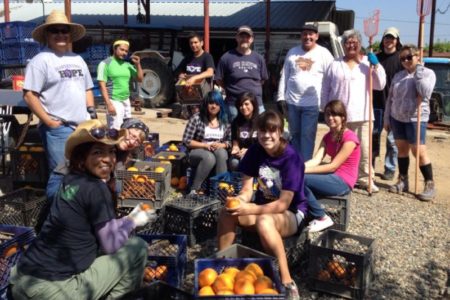
Source: https://www.facebook.com/mohsharvestinghope
Besides serving those in need, produce gleaning has helped Tulare County residents come together, get to know one another, and enjoy the natural beauty of the Central Valley.
“It’s just a great thing to do in your community,” Beals said.
This success story was produced by Salud America! with support from the Robert Wood Johnson Foundation.
The stories are intended for educational and informative purposes. References to specific policymakers, individuals, schools, policies, or companies have been included solely to advance these purposes and do not constitute an endorsement, sponsorship, or recommendation. Stories are based on and told by real community members and are the opinions and views of the individuals whose stories are told. Organization and activities described were not supported by Salud America! or the Robert Wood Johnson Foundation and do not necessarily represent the views of Salud America! or the Robert Wood Johnson Foundation.
ABOUT THE PROGRAM
Salud America! The RWJF Research Network to Prevent Obesity Among Latino Children is a national program of the Robert Wood Johnson Foundation. The program aims to educate researchers, decision-makers, community leaders, and the public in contributing toward healthier Latino communities and seeking environmental and policy solutions to the epidemic of Latino childhood obesity. The network is directed by the Institute for Health Promotion Research at the University of Texas Health Science Center at San Antonio.
For more information, visit http://www.salud-america.org.
By The Numbers
1
Supermarket
for every Latino neighborhood, compared to 3 for every non-Latino neighborhood
This success story was produced by Salud America! with support from the Robert Wood Johnson Foundation.
The stories are intended for educational and informative purposes. References to specific policymakers, individuals, schools, policies, or companies have been included solely to advance these purposes and do not constitute an endorsement, sponsorship, or recommendation. Stories are based on and told by real community members and are the opinions and views of the individuals whose stories are told. Organization and activities described were not supported by Salud America! or the Robert Wood Johnson Foundation and do not necessarily represent the views of Salud America! or the Robert Wood Johnson Foundation.



